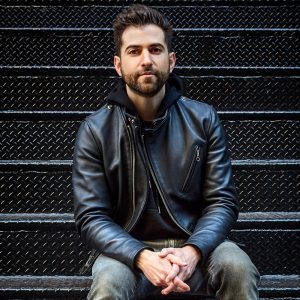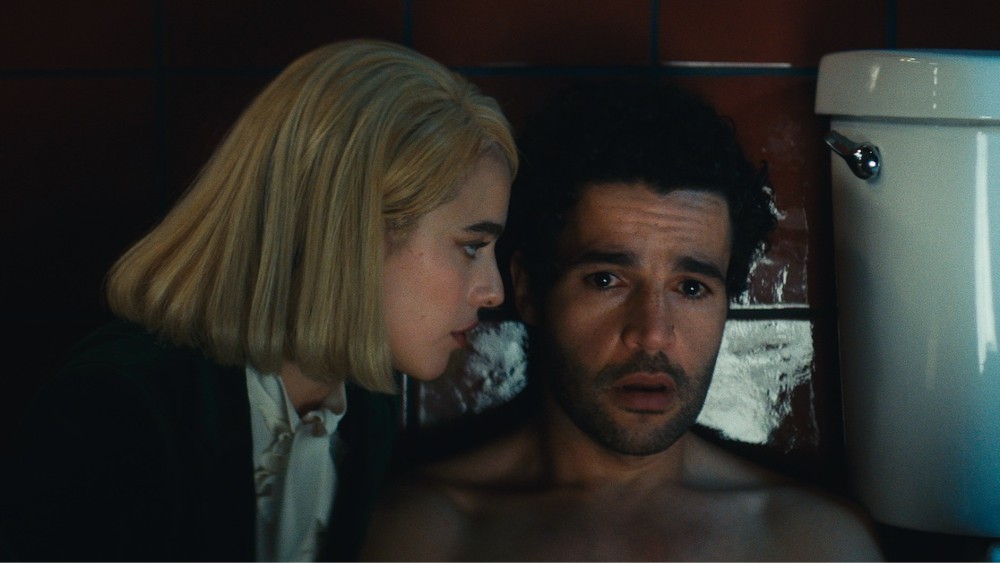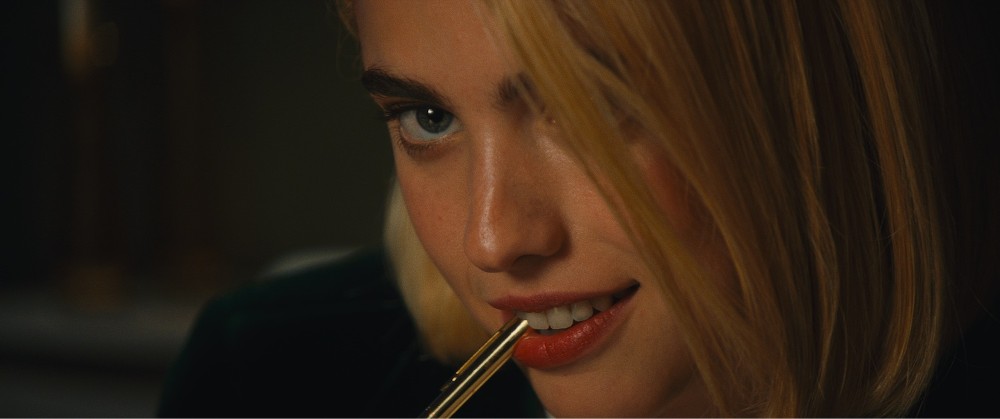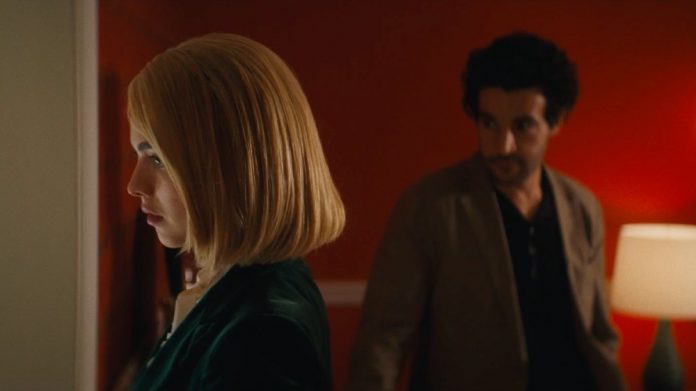A fetching young woman with short blonde hair raps on the door of a luxury hotel suite occupied by a young man who is clearly distraught over something happening in his life. The woman, Rebecca (Margaret Qualley, Once Upon a Time in Hollywood) is there to perform certain services as a dominatrix to help Hal, (Christopher Abbott, Possessor), the son of a newly-deceased billionaire industrialist, get his mind off things.
With Hal poised to take over as CEO of his father’s company, Rebecca worries she’s about to lose her meal ticket, so she takes matters into her own hands and blackmails Hal for money — and more. What will Hal do to prevent Rebecca from ruining his life — or is ruination part of his kink?
That’s the intriguing setup for director Zachary Wigon‘s kinky new indie movie Sanctuary, written by Micah Bloomberg. The film serves as Wigon’s follow-up to The Heart Machine, a 2014 indie drama starring John Gallagher Jr. and Kate Lyn Sheil, and it certainly ups the game on what can be done in a single location with just two actors (mainly), as Sanctuary features the kind of jaw-dropping interplay that will make you blush depending on your sensibilities.
Above the Line recently hopped on Zoom with Wigon, who talked about making an effective two-hander that goes to all sorts of unexpected places. He also shed light on the genesis of the project, as well as his visual inspirations for the film.

Above the Line: I read that this movie came out of a conversation you had with screenwriter Micah Bloomberg. Or was he already writing something and that got you interested?
Zachary Wigon: Basically, the way that it started was, it was June 2020. We were on the phone, and Micah said, ‘You know, I really need to write some scenes. Let’s develop something together. Let’s develop a feature. I’ll write it, you direct it.’ And I said, ‘Yeah, let’s do it.’ Micah and I had collaborated together in a number of different capacities; I’ve known him for a number of years.
For a number of years, I had been interested in the idea of making a thriller about a dominatrix. I felt like it was a good idea for a movie because it had an interesting paradox in the nature of the character’s job. Basically, I pitched Micah this very vague idea, a story about a dominatrix who robs her wealthiest client — that was the original pitch.
Micah said, ‘You know, it’s funny. I wrote a one-act play a number of years ago about a dominatrix and her client in a hotel room.’ We had both been interested in that idea, so at that point, we were like, ‘Alright, There’s probably a movie here,’ and so we started talking from there, and that’s where the idea was built from.
ATL: How long did it take you to develop that script and get it to the point where you could take it out to actors?
Wigon: I think the script development took about six months, and then there was the holiday break. The way things are timed in terms of how scripts go out, it was about six months of developing the script, and a couple [of] months later, we wound up attaching the production company and then going out to Margaret — and then Chris.
ATL: Was Neon already involved during production, or did they get involved following its premiere at TIFF?
Wigon: They bought it out of TIFF.
ATL: For the most part, Margaret and Chris are the only two actors, so how did you know they were the right duo, and what had you seen them in prior to working with them?
Wigon: I remember seeing Once Upon a Time in Hollywood and looking at Margaret’s performance. I thought, “This performance is so electric and so interesting, [with] all the physical gestures that she’s doing.” She put so much into every tick and movement of that character, I was absolutely fascinated by the work that she was doing, and her screen effect was so sharp and interesting. I also saw her in Fosse/Verdon, where she plays a completely different character with a completely different effect, very vulnerable, like 180 degrees from Once Upon a Time in Hollywood. I just thought, “Margaret’s range is just phenomenal,” so I wanted to work with her and I thought she’d be perfect for this.
Chris, I had been a fan of for many, many years. He’s been phenomenal in so many great movies, and I had heard that he was a fan of my first movie, so for a number of years, I had been interested in working with him. I just thought that he would be perfect for this as well. We really lucked out — they’re both exceptionally talented.
ATL: Obviously, this film came together in the middle of the pandemic, so did you and Micah meet with your leads over Zoom, or were you able to get together in person prior to production? Was post-production done remotely?
Wigon: [This] was after people were just starting to get vaccinated. They got attached in May of 2021, and then we were shooting by the beginning of August 2021, [so yeah], we were meeting in person, sitting down, talking about the characters, talking about the general flow of the story [and] the sequences.

ATL: I read that you didn’t do a ton of rehearsal with Margaret and Chris before shooting.
Wigon: I always feel like… I didn’t come up with this — somebody used this expression, I can’t remember where [I read it] — but you don’t want the plane to take off until the cameras are rolling. You want to get them in the vicinity. The other thing is when you’re working with really talented actors, in my opinion, you really just don’t have to do that much. You need to let them do their thing and give them the space to do their thing.
Basically, we talked a bit about the story [and] the characters in prep, but really, you just want to touch it with rehearsal once or twice, just to get everybody’s feet wet. And then let them really find it on the day. That’s the approach that’s worked for me, and that’s what we did on this one.
ATL: This seems like it could have been a pretty intense shoot, just by the nature of the material and the relationship the characters have, and what happens between them. Did you have a space where you could just shoot it in order and give the actors long takes?
Wigon: I don’t think it could have been done any other way. It was all done on a stage. We built everything, so we controlled everything. That always makes it easier for everybody to focus — there are [fewer] outside distractions. We shot it in sequence, and that was really important for me. I can’t speak for Margaret and Chris, but I believe for them as well.
[And] yeah, it was intense. We would be in the dining room, and then we would be like, ‘Alright, everybody, we’re going into the living room, we’re going into the bedroom, [and now] we’re going into the bathroom, [and then] we’re back in the living room.’ We only had 18 days to shoot the movie, but because we were shooting in sequence, it was much slower, in terms of how the shoot is going. You’re not shooting out of a corner of a room for the whole feature.
Fortunately, we had an absolutely phenomenal crew, and we got it all, so it worked out. It was definitely intense. It was five days on and then one-day weekends.
ATL: I was curious about the coverage you were doing, and whether you were able to let the actors do entire scenes before changing camera angles and such.
Wigon: There’s a lot of dialogue, and I think one of the longest [shots] that we did was… we had two cameras when we did the dinner scene after their session, so for the dinner scene, in particular, I think that was about 13 pages. We shot with two cameras, and we flipped 180 in the middle of that scene. So we shot with two cameras straight for about six and a half pages of script, [then we] flipped and [did it] again — six and a half pages of script. I was enormously fortunate to have Chris and Margaret because they were completely off-book. I don’t think we could have done it any other way. They were phenomenal. They were doing it like it was a play.
ATL: It’s interesting you say that because, in theory, this could be a play, so what was behind the drive to do it as a movie, especially as someone who has made an independent film before, so you know how hard they are to get made right now.
Wigon: On the cinematic level of it, I was interested in the visual challenge of trying to do a movie set in one location with two actors and have it feel, not just like a really good filmed play, but have it feel like a movie that is meant to be a movie [and] have it work with the language of cinema. That challenge was really exciting to me because I felt like it would be pretty difficult. That came down to just making sure that the blocking was always changing, that we were never repeating blocking positions, and that we were never repeating camera positions or camera setups, [so] we never went back to the same shot.
My rule for myself was, if you do shot/countershot, then you can go back to it because that’s a shot/countershot situation, but you never want to go back to a setup that you’ve used earlier in the movie. At first, I was like, ‘Okay, this is intense,’ but with 1200 square feet in the hotel suite, it was difficult, but not impossible. The challenge of that was really exciting for me.

ATL: At this point, I’m sure you’ve heard the term “pandemic movie” whenever a movie has only one or two actors in a single location. Do you think the limitations surrounding production made it easier to get a two-hander like this up and running?
Wigon: It’s a cost-effective way to make a film when you have two actors in one location. There’s certainly that to it. Absolutely, on the producing side, that must have made things a little bit easier. It’s always a challenge to get any movie made, but I would imagine that helps things out.
ATL: I’ve always found production design to be quite fascinating, so what were some of the influences and inspirations for the luxury hotel location where the film takes place? Did you just check out a lot of actual hotels in New York City?
Wigon: Something that I’ve noticed is that [in] a lot of contemporary hotels, the design scheme seems to be really big windows, and then minimalist interior, and it’s taupe or off-white. That was not going to work for this, because we’re in this hotel suite for 90 minutes, so it has to be visually interesting. It needed to be an interior that was visually busy in a way that worked with the emotions of the movie, that helped you feel the way the characters feel, and also just kept your eye from being bored.
One hotel inspiration that I was thinking about [was] Kemp’s hotels like The Crosby Street Hotel, for example, where the interiors are very busy, there’s a lot going on, and it’s really aesthetically interesting. This is more [of] a jewel tone and a darker palette than those. With the jewel tone look, the idea was basically about creating a situation where the viewer feels very sensitive, like their senses are on high alert — in the same way that the characters do. Jason Singleton, who did the production design, did a wonderful job of really bringing that to life.
ATL: How much did your tenure as a film critic inform your filmmaking? Or vice versa? I have to imagine if you’re making movies and then watching someone else’s movie, you must think about how you would’ve done things differently. Is there any internal back-and-forth like that?
Wigon: I haven’t written film criticism in a long time. Being a film director was always what was interesting to me. It was fun to write film criticism. I never felt like I was in the groove of writing film criticism at necessarily a great level. I felt like I was okay at it. It’s interesting because there was a very brief window after The Heart Machine was made where I was still writing a little bit of criticism. I actually felt like making The Heart Machine helped me write film criticism a little bit better, because for me, anyway, it helped me understand some of the narrative mechanics. I think that just spoke to where I was at, as a writer about movies.
As far as the way that writing film criticism affected my filmmaking, I guess the only way that I can think about that is, for me anyway, it forced me to think analytically and intellectually about genre and the way that certain types of movies tend to function. Thinking in that way definitely does help understand the contract between a certain kind of movie and the audience.
Sanctuary is now playing in select theaters courtesy of Neon.



